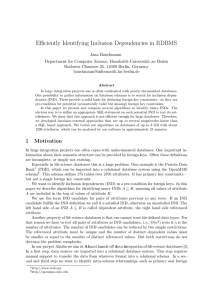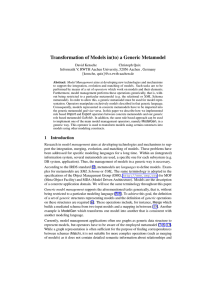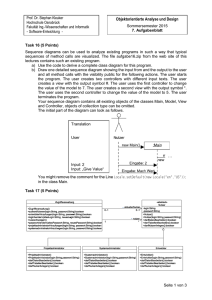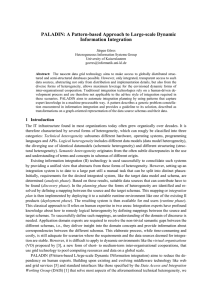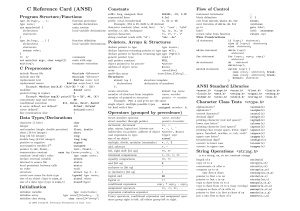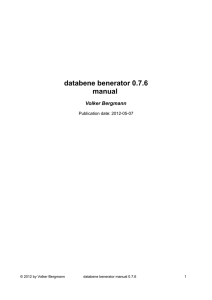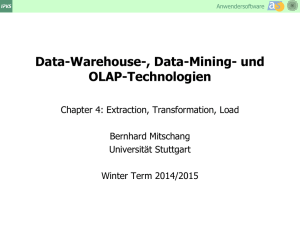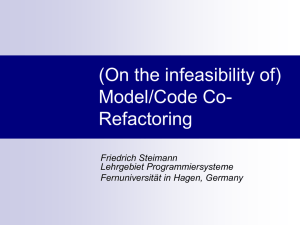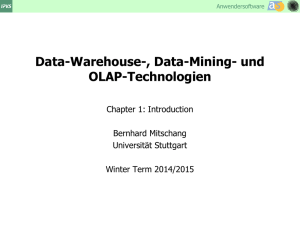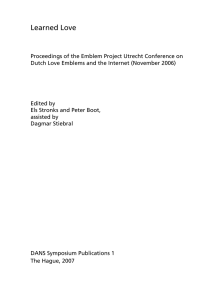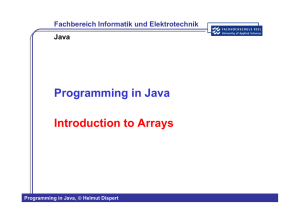Matisse ODL Programmer`s Guide
Werbung
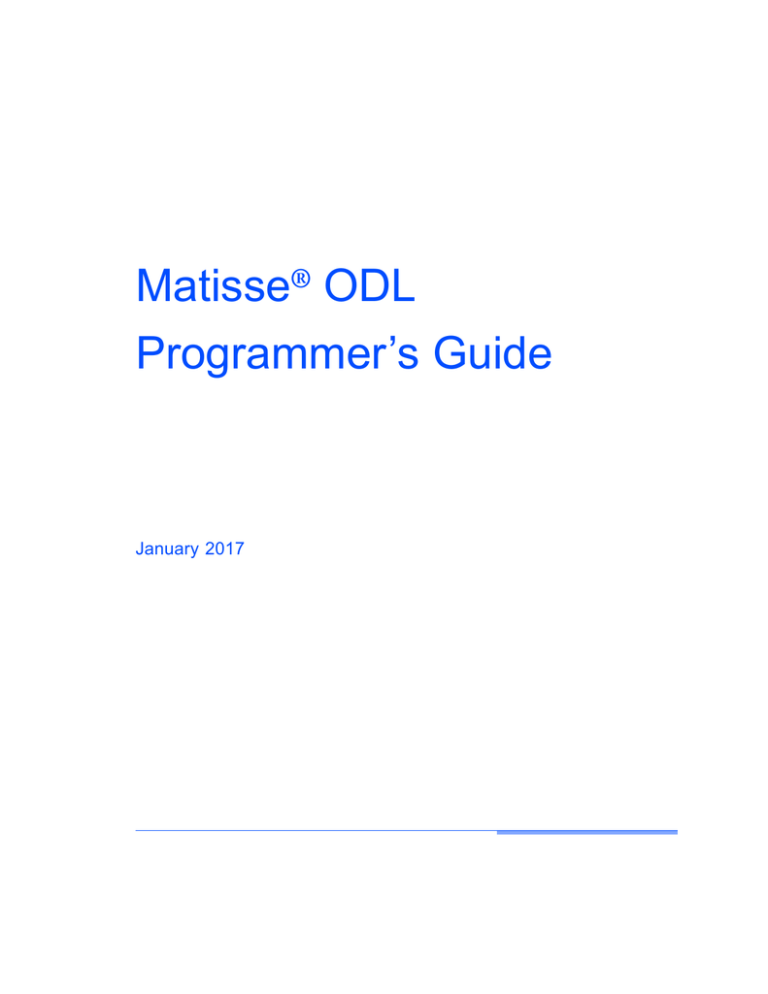
Matisse® ODL
Programmer’s Guide
January 2017
Matisse ODL Programming Guide
Copyright © 2017 Matisse Software Inc. All Rights Reserved.
This manual and the software described in it are copyrighted. Under the
copyright laws, this manual or the software may not be copied, in whole or in
part, without prior written consent of Matisse Software Inc. This manual and
the software described in it are provided under the terms of a license between
Matisse Software Inc. and the recipient, and their use is subject to the terms of
that license.
RESTRICTED RIGHTS LEGEND: Use, duplication, or disclosure by the
government is subject to restrictions as set forth in subparagraph (c)(l)(ii) of the
Rights in Technical Data and Computer Software clause at DFARS 252.2277013 and FAR 52.227-19.
The product described in this manual may be protected by one or more U.S. and
international patents.
TRADEMARKS: Matisse and the Matisse logo are registered trademarks of
Matisse Software Inc. All other trademarks belong to their respective owners.
PDF generated 7 January 2017
Matisse ODL Programming Guide
Contents
1
2
Introduction . . . . . . . . . . . . . . . . . . . . . . . . . . . . . . . . . . . . . . . . . . . . . . . . . . . . . . . . . . . . . . . . . . . . 4
1.1
Scope of This Document . . . . . . . . . . . . . . . . . . . . . . . . . . . . . . . . . . . . . . . . . . . . . . . . . . . . . . . . . . . . . . . 4
1.2
Before Reading This Document . . . . . . . . . . . . . . . . . . . . . . . . . . . . . . . . . . . . . . . . . . . . . . . . . . . . . . . . . 4
1.3
SQL DDL and Matisse Modeler . . . . . . . . . . . . . . . . . . . . . . . . . . . . . . . . . . . . . . . . . . . . . . . . . . . . . . . . . . 4
Creating a Schema with ODL . . . . . . . . . . . . . . . . . . . . . . . . . . . . . . . . . . . . . . . . . . . . . . . . . . . . . . 5
2.1
3
2.2
Specifying Namespaces with ODL . . . . . . . . . . . . . . . . . . . . . . . . . . . . . . . . . . . . . . . . . . . . . . . . . . . . . . . 7
2.3
Specifying Classes with ODL . . . . . . . . . . . . . . . . . . . . . . . . . . . . . . . . . . . . . . . . . . . . . . . . . . . . . . . . . . . 8
2.4
Specifying Attributes with ODL . . . . . . . . . . . . . . . . . . . . . . . . . . . . . . . . . . . . . . . . . . . . . . . . . . . . . . . . . . 9
2.5
Specifying Relationships with ODL . . . . . . . . . . . . . . . . . . . . . . . . . . . . . . . . . . . . . . . . . . . . . . . . . . . . . . 13
2.6
Specifying Indexes with ODL . . . . . . . . . . . . . . . . . . . . . . . . . . . . . . . . . . . . . . . . . . . . . . . . . . . . . . . . . . . 15
2.7
Specifying Entry-Point Dictionaries with ODL . . . . . . . . . . . . . . . . . . . . . . . . . . . . . . . . . . . . . . . . . . . . . . 16
2.8
Specifying SQL Methods with ODL . . . . . . . . . . . . . . . . . . . . . . . . . . . . . . . . . . . . . . . . . . . . . . . . . . . . . . 17
Using the mt_sdl utility . . . . . . . . . . . . . . . . . . . . . . . . . . . . . . . . . . . . . . . . . . . . . . . . . . . . . . . . . . 18
3.1
4
5
Overview of ODL Programming . . . . . . . . . . . . . . . . . . . . . . . . . . . . . . . . . . . . . . . . . . . . . . . . . . . . . . . . . . 5
Loading a schema . . . . . . . . . . . . . . . . . . . . . . . . . . . . . . . . . . . . . . . . . . . . . . . . . . . . . . . . . . . . . . . . . . . 18
3.2
Exporting a schema . . . . . . . . . . . . . . . . . . . . . . . . . . . . . . . . . . . . . . . . . . . . . . . . . . . . . . . . . . . . . . . . . . 18
3.3
Generating class files . . . . . . . . . . . . . . . . . . . . . . . . . . . . . . . . . . . . . . . . . . . . . . . . . . . . . . . . . . . . . . . . 18
3.4
Updating an application . . . . . . . . . . . . . . . . . . . . . . . . . . . . . . . . . . . . . . . . . . . . . . . . . . . . . . . . . . . . . . . 19
3.5
Preprocessing a schema file . . . . . . . . . . . . . . . . . . . . . . . . . . . . . . . . . . . . . . . . . . . . . . . . . . . . . . . . . . . 20
Extending the Meta-Schema with ODL . . . . . . . . . . . . . . . . . . . . . . . . . . . . . . . . . . . . . . . . . . . . . 21
4.1
Matisse Meta-Schema . . . . . . . . . . . . . . . . . . . . . . . . . . . . . . . . . . . . . . . . . . . . . . . . . . . . . . . . . . . . . . . . 21
4.2
Modifying the Meta-Schema . . . . . . . . . . . . . . . . . . . . . . . . . . . . . . . . . . . . . . . . . . . . . . . . . . . . . . . . . . . 21
4.3
Extending Meta-Schema Classes . . . . . . . . . . . . . . . . . . . . . . . . . . . . . . . . . . . . . . . . . . . . . . . . . . . . . . . 21
4.4
Adding an Attribute to a Meta-Class . . . . . . . . . . . . . . . . . . . . . . . . . . . . . . . . . . . . . . . . . . . . . . . . . . . . . 22
4.5
Adding a Relationship to a Meta-Class . . . . . . . . . . . . . . . . . . . . . . . . . . . . . . . . . . . . . . . . . . . . . . . . . . . 22
4.6
Extending Matisse MtAttribute . . . . . . . . . . . . . . . . . . . . . . . . . . . . . . . . . . . . . . . . . . . . . . . . . . . . . . . . . . 23
4.7
Extending Matisse MtRelationship . . . . . . . . . . . . . . . . . . . . . . . . . . . . . . . . . . . . . . . . . . . . . . . . . . . . . . 24
4.8
Extending Matisse MtClass . . . . . . . . . . . . . . . . . . . . . . . . . . . . . . . . . . . . . . . . . . . . . . . . . . . . . . . . . . . . 25
Sharing Properties with ODL . . . . . . . . . . . . . . . . . . . . . . . . . . . . . . . . . . . . . . . . . . . . . . . . . . . . . 27
5.1
Shared Properties . . . . . . . . . . . . . . . . . . . . . . . . . . . . . . . . . . . . . . . . . . . . . . . . . . . . . . . . . . . . . . . . . . . 27
5.2
Defining a Shared Attribute . . . . . . . . . . . . . . . . . . . . . . . . . . . . . . . . . . . . . . . . . . . . . . . . . . . . . . . . . . . . 27
5.3
Defining a Shared Relationship . . . . . . . . . . . . . . . . . . . . . . . . . . . . . . . . . . . . . . . . . . . . . . . . . . . . . . . . . 28
5.4
Defining a Shared Index . . . . . . . . . . . . . . . . . . . . . . . . . . . . . . . . . . . . . . . . . . . . . . . . . . . . . . . . . . . . . . 28
5.5
Defining a Shared Entry-Point Dictionary . . . . . . . . . . . . . . . . . . . . . . . . . . . . . . . . . . . . . . . . . . . . . . . . . 29
Index . . . . . . . . . . . . . . . . . . . . . . . . . . . . . . . . . . . . . . . . . . . . . . . . . . . . . . . . . . . . . . . . . . . . . . . . . . . . . 30
Contents
3
Matisse ODL Programming Guide
1 Introduction
1.1 Scope of This Document
This document is a guide to using Matisse’s Object Definition Language (ODL) to create Matisse
database schemas. It covers all aspects of ODL programming and use of the mt_sdl utility that are the
same regardless of which language binding(s) you use.
General information about designing Matisse database schemas is covered in Getting Started with
MATISSE. Binding-specific aspects of Matisse ODL are covered in the C++, Java, PHP, Python and
Eiffel binding programmer’s guides.
1.2 Before Reading This Document
Throughout this document, we presume that you have read Getting Started with MATISSE, which
provides an overview of Matisse schema elements and a discussion on schema design.
1.3 SQL DDL and Matisse Modeler
You may use SQL DDL (Data Definition Language) or Matisse modeling tool to create or update Matisse
database schema. For more information, refer to Matisse SQL Programmer’s Guide or Matisse Modeler
User’s Guide.
Note that you need to use an ODL file to generate persistent stub classes for the C++, Java, PHP, Python
or Eiffel bindings. However, you can generate an ODL file from the Matisse database using the mt_sdl
utility, or the Matisse Enterprise Manager, after you create the database schema using SQL DDL or the
Matisse Modeler. For more information about mt_sdl, read 3 Using the mt_sdl utility
4
Introduction
Matisse ODL Programming Guide
2 Creating a Schema with ODL
2.1 Overview of ODL Programming
To to create a schema in Matisse ODL, you create
an .odl file, a text file containing a set of ODL
declarations. You can then use the mt_sdl
utility or the Matisse Enterprise Manager to load
the schema in a newly initialized database and to
generate source code for use with the C++, Java,
PHP, Python or Eiffel binding.
The following is the ODL code for the schema
diagrammed at right:
interface Person : persistent {
attribute String firstName;
attribute String lastName;
attribute String<500> Nullable
comment;
attribute Integer Nullable age =
NULL;
attribute Image Nullable photo =
NULL;
relationship Person spouse[0, 1]
inverse Person::spouse;
relationship List<Person>
children
inverse Person::father;
readonly relationship Person
father[0, 1]
inverse Person::children;
};
interface Employee : Person :
persistent {
attribute Date hireDate;
attribute Numeric(10, 2) salary;
relationship Manager reportsTo
inverse Manager::team;
};
interface Manager : Employee : persistent {
relationship List<Employee> team[1, -1]
inverse Employee::reportsTo;
relationship Employee assistant[0, 1];
};
Creating a Schema with ODL
5
Matisse ODL Programming Guide
Default cardinality for a relationship declared using relationship List<Class_name> is 0, -1,
while for a relationship declared using relationship Class_name default cardinality is 1, 1. Thus
the cardinality does not need to be declared for the children or reportsTo relationships. See
Specifying Relationships with ODL on page 13 for more information.
6
Creating a Schema with ODL
Matisse ODL Programming Guide
2.2 Specifying Namespaces with ODL
Define a
namespace
module Namespace_name {...};
Associated classes, indexes and entry-point dictionaries are declared within the
brackets.
For example, defining Person and Company classes in MyCompany.MyApp
namespace and Employee and Manager in sub-namespace HR:
module MyCompany
{
module MyApp
{
interface Person : persistent
{
attribute String<16> name;
};
interface Company : persistent
{
attribute String<32> name;
};
module HR
{
interface Employee: MyCompany.MyApp.Person: persistent
{
};
interface Manager: Employee: persistent
{
};
};
};
};
Creating a Schema with ODL
7
Matisse ODL Programming Guide
2.3 Specifying Classes with ODL
Define a class
interface Class_name : persistent {...};
Associated attributes, relationships, indexes and entry-point dictionaries are
declared within the brackets, separated by semicolons.
Extend a class
interface Class_name : Superclass_name : persistent {...};
Extends an existing class (Superclass_name) to create a subclass. The subclass
inherits all of the properties of the superclass.
For the multiple inheritance, enumerate the superclasses separated with a comma:
interface Class_name : Superclass1, Superclass2 : persistent
{...};
8
Creating a Schema with ODL
Matisse ODL Programming Guide
2.4 Specifying Attributes with ODL
Basic declaration
(name and type)
attribute type Attibute_name
Specifies an attribute of type, where type is the ODL name for one of Matisse’s
scalar (Boolean, Byte, Char, Date, Double, Float, Integer,
Interval, Long, Numeric, Short, String, or Timestamp) or streamable
(Audio, Bytes, Image, Text, Video) data types. For additional
information, see the Matisse Data Type Reference.
Creating a Schema with ODL
9
Matisse ODL Programming Guide
Table 1
Scalar types and media types
Type
Description
Boolean
True or false
Byte
A single byte. Valid range is from 0 to 255.
Char
A single byte character.
Date
Year, month, and day values of date
Double
A double-precision floating-point number, 64-bit
approximation of a real number.
Float
A single-precision floating-point number, 32-bit
approximation of a real number.
Integer
4-byte signed integer.
Interval
A period of time in days, hours, minutes, seconds, and
micro-seconds.
Long
8-byte signed integer.
Numeric
Numeric(p, s)
A fixed-point decimal number having precision p and
scale s. Default precision and scale is 19 and 2.
Precision sets the total number of digits and scale sets
the number of those digits to the right of the decimal
point.
10
Short
2-byte signed integer.
String
String<n>
A variable length character string, optionally having the
maximum length n. The maximum length is 2147483648
(2Gbytes). If n is not specified, the maximum size is
2147483648.
String UTF16
String<n> UTF16
A variable length Unicode character string, optionally
having the maximum number of characters n. The
maximum number of characters is 1073741824 (1G). If n
is not specified, the maximum is 1073741824.
Timestamp
Date and time consisting of year, month, day, hour,
minute, second, and micro-second.
Creating a Schema with ODL
Matisse ODL Programming Guide
List types
Type
Description
Audio
Audio<n>
Bytes
Bytes<n>
Image
Image<n>
Video
Video<n>
Streamable binary large object, optionally having the
maximum size n in bytes. The maximum size of these
types is 2147483648. If n is not specified the maximum
size is 2147483648.
Text
Text<n>
Streamable character large object, optionally having the
maximum length n in bytes. The maximum length of this
type is 2147483648. If n is not specified the maximum
length is 2147483648.
Text UTF16
Text<n> UTF16
Streamable Unicode character large object, optionally
having the maximum number of characters n. The
maximum number of characters of this type is
1073741824. If n is not specified the maximum length is
1073741824.
attribute List<type> Attibute_name
attribute List<type, max_elements> Attibute_name
Defines the type as the LIST variation of the specified scalar type. It optionally
specifies the maximum number of elements allowed in a list. For additional
information, see the Matisse Data Type Reference.
The following is the list of available list types:
List<Boolean>
List<Date>
List<Double>
List<Float>
List<Integer>
List<Interval>
List<Long>
List<Numeric>
List<Short>
List<String>
List<String UTF16>
List<Timestamp>
Nullable flag
attribute type Nullable Attibute_name
Allows null values. If you specify Nullable and do not specify a default value,
the attribute value will default to NULL. For example, in the case of a
DateOfDeath attribute, a null would be appropriate for a living person.
Creating a Schema with ODL
11
Matisse ODL Programming Guide
Default value
attribute type Attibute_name = default_value
Explicitly defines a default value (which must be compatible with type). Syntax for
default_value varies with the type:
Type
Default value syntax
Boolean
TRUE|FALSE
Byte
Byte(value)
Char
'a'
Date
Date("YYYY-MM-DD")
Double
Double(value)
Float
Float(value)
Integer
value
Interval
Interval("[-]days HH:MM:SS.MMMMMM")
Note that there is a space after the days value.
Long
Long(value)
Numeric
Numeric(0.00) (The only default value allowed is 0.)
Short
Short(value)
String
"string"
String UTF16
UTF16("cycling")
UTF16("v\u00E9lo")
UTF16("\u81EA\u884C\u8F66")
Timestamp
Timestamp("YYYY-MM-DD HH:MM:SS.MMMMMM")
Audio
Audio()
Bytes
Bytes()
Image
Image()
Text
Text("string")
Text UTF16
Text UTF16("cycling")
Text UTF16("v\u00E9lo")
Text UTF16("\u81EA\u884C\u8F66")
Video
Video()
attribute type nullable Attibute_name = NULL
Sets the default value to NULL.
attribute List<type> Attibute_name = List<type>{ default_value_1,
default_value_2, ...}
Sets a list of default values.
12
Creating a Schema with ODL
Matisse ODL Programming Guide
attribute List<type> Attibute_name = List<type>{}
Sets the default value as an empty list.
To change a default value, revise the ODL file and use mt_sdl to update the
database (see Loading a schema on page 18).
Scalar default
value examples
List default value
examples
attribute Boolean Attibute_name = TRUE
attribute Byte Attibute_name = Byte(0)
attribute Char Attibute_name = 'A'
attribute Date Attibute_name = Date("1997-07-29")
attribute Double Attibute_name = Double(0.000000)
attribute Float Attibute_name = Float(0.000000)
attribute Integer Attibute_name = 0
attribute Interval Attibute_name = Interval("-29 12:00:00")
attribute Long Attibute_name = Long(0)
attribute Numeric Attibute_name = Numeric(0)
attribute Short Attibute_name = Short(0)
attribute String<32> Attibute_name = "ascii string"
attribute String<32> UTF16 Attibute_name = UTF16("v\u00E9lo")
attribute Text Attibute_name = Text("ascii string")
attribute Text UTF16 Attibute_name = Text
UTF16("\u81EA\u884C\u8F66")
attribute Timestamp Attibute_name = Timestamp("2000-12-31
12:00:00")
attribute List<Boolean> Attibute_name = List<Boolean>{ TRUE, FALSE
}
attribute List<Byte> Attibute_name = List<Byte>{ 11, 21 }
attribute List<Double> Attibute_name = List<Double>{ 11.100000,
21.100000 }
attribute List<Float> Attibute_name = List<Float>{ 11.100000,
21.100000 }
attribute List<Integer> Attibute_name = List<Integer>{ 11, 21 }
attribute List<Interval> Attibute_name = List<Interval>{
Interval("-19 12:00:00"), Interval("-29 12:00:00") }
attribute List<Long> Attibute_name = List<Long>{ 11, 21 }
attribute List<Numeric>{ Numeric(0.00, 0.00)}
attribute List<Short> Attibute_name = List<Short>{ 11, 21 }
attribute List<String> Attibute_name = List<String>{ "a","b","c" }
attribute List<String UTF16> Attibute_name = List<String>{
UTF16("cycling"), UTF16("v\u00E9lo"),
UTF16("\u81EA\u884C\u8F66") }
attribute List<Timestamp> Attibute_name = List<Timestamp>{
Timestamp("2000-12-31 12:00:00"), Timestamp("2001-01-01
12:00:00") }
2.5 Specifying Relationships with ODL
Basic declaration
(name and default
cardinality)
There are three ways to declare a relationship:
relationship Successor_class Direct_name
Creating a Schema with ODL
13
Matisse ODL Programming Guide
relationship List <Successor_class> Direct_name
relationship Set <Successor_class> Direct_name
You may also define an inverse relationship for all these declarations:
relationship Successor_class Direct_name
inverse Successor_class::Inverse_name
relationship List <Successor_class> Direct_name
inverse Successor_class::Inverse_name
relationship Set <Successor_class> Direct_name
inverse Successor_class::Inverse_name
When you declare a relationship with List or Set, the default cardinality is
[0, -1] (any number of successors); without List or Set, the default
cardinality is [1, 1] (one successor).
If you define and inverse relationship, the relationships must be declared in each
of the two classes involved. For example:
interface Employee: persistent {
relationship Department MemberOf inverse
Department::Members;
};
interface Department: persistent {
relationship List <Person> Members inverse Person::MemberOf;
};
Cardinality
relationship ... Direct_name [min_#_succs, max_#_succs] ...
Cardinality is specified on the direct relationship part. To explicitly set cardinality
for both ends of a relationship, specify it for each of the direct declarations.
When List or Set is used, cardinality if not set explicitly is [0, -1]
(minimum zero, maximum unlimited): any number of successors, or none, may be
specified. Thus the following two declarations are equivalent:
relationship List<Person> Members
relationship List<Person> Members [0, -1]
With List or Set, you may explicitly set any minimum and maximum, for
example:
relationship List ... Direct_name [0, 2] ...
relationship List ... Direct_name [3, 10] ...
relationship List ... Direct_name [2, -1] ...
Without List or Set, cardinality if not set explicitly is [1, 1]: one and
only one successor must be specified. Thus the following two declarations are
equivalent:
relationship Department MemberOf inverse ...
14
Creating a Schema with ODL
Matisse ODL Programming Guide
relationship Department MemberOf [1, 1] inverse ...
The only other cardinality supported without List or Set is [0, 1]: a
single successor, or none, may be specified.
Whenever the minimum cardinality is greater than 0, the relationship must always
have a successor. In this case, any transaction that creates an object or clears all
successors must set a successor before it can be committed.
Order
“Read-only”
When you declare a relationship with List, the order of successors of the
relationship is preserved. On the other hand, if you declare a relationship with
Set, the order of successors need not be preserved.
readonly relationship ...
When readonly is specified, the direct relationship can be used to get or query
successors, but cannot be used to update or delete.
Multiple successor
classes
relationship List <Successor_class_1, Successor_class_2>
Direct_name inverse Inverse_name
A relationship may have more than one successor class: for example, the class
Person might have a relationship Owner / OwnedBy with the classes Car and
House.
Usually a more straightforward and flexible way to represent such real-world
correspondences is with inheritance. For example, Person would have a
relationship Owner / OwnedBy with the class Property, which would have
subclasses Car and House.
Note that this is not an “n-ary” relationship: that is, it cannot be used to create
links between Successor_class_1 objects and Successor_class_2 objects.
2.6 Specifying Indexes with ODL
Index criteria
mt_index Index_name criteria
{Class_name::Attribute1_name sort_order},
{Class_name::Attribute2_name sort_order},
{Class_name::Attribute3_name sort_order},
{Class_name::Attribute4_name sort_order};
An index may include up to four of its class’s attributes (which may be inherited
from superclasses rather than declared in the class) that are referred as criteria for
the index. For example:
interface Person : persistent
{
attribute String<16> firstName;
attribute String<16> lastName;
mt_index personName
criteria {person::lastName MT_ASCEND},
{person::firstName MT_ASCEND};
Creating a Schema with ODL
15
Matisse ODL Programming Guide
};
sort_order
must be either MT_ASCEND or MT_DESCEND.
The maximum size allowed for a key is 256 bytes. Thus the sum of the sizes for
the attributes that are indexed cannot exceed 256 bytes.
Unique key
mt_index Index_name
unique_key TRUE
criteria
{Class_name::Attribute1_name sort_order}...
If set to TRUE, each entry in the index must be unique, allowing them to be used
as primary keys. The default is FALSE, so if this option is not specified the index
may contain duplicate entries. unique_key must be specified before
criteria.
2.7 Specifying Entry-Point Dictionaries with ODL
NOTE:
Basic declaration
Use entry-point dictionaries with attributes of type String only. For
other data types, use indexes.
mt_entry_point_dictionary Dictionary_name
entry_point_of Attribute_name
Creates an entry-point dictionary for the attribute. Options must be specified in the
order shown in this example for an attribute comment):
interface Document : persistent
{
attribute String comment;
mt_entry_point_dictionary commentDict
entry_point_of comment
unique_key FALSE
case_sensitive FALSE
make_entry_function "make-full-text-entry";
};
Unique key
mt_entry_point_dictionary Dictionary_name
entry_point_of Attribute_name unique_key TRUE
If set to TRUE, each entry in the dictionary must be unique, allowing them to be
used as primary keys. The default is FALSE, so if this option is not specified the
dictionary may contain duplicate entries.
Case sensitivity
16
mt_entry_point_dictionary Dictionary_name
Creating a Schema with ODL
Matisse ODL Programming Guide
entry_point_of Attribute_name case_sensitive TRUE
If set to TRUE, dictionary lookups are case-sensitive. Otherwise, they are caseinsensitive. The default is FALSE, so if this option is not specified lookups are
case-insensitive.
Function
mt_entry_point_dictionary Dictionary_name
entry_point_of Attribute_name make_entry_function "function_name"
function_name specifies the function to be used to generate the dictionary. Two such
functions are included with Matisse:
•
"make-entry" (default): generates one entry point per object based on the
attribute value
•
"make-full-text-entry": generates a separate entry point for each
word in the string
If no function is specified, Matisse will use the default method, make-entry.
2.8 Specifying SQL Methods with ODL
Basic declaration
mt_method "SQL_DDL_statement"
SQL_DDL_Statement is either a CREATE METHOD statement or a CREATE
STATIC METHOD statement. This generates a SQL method in the database for a
class. For more information about SQL methods, refer to Matisse SQL
Programmer’s Guide.
When you use a double quotation mark (") within mt_method, it needs to be
preceded by a backslash (\).
Example
The following example defines a method which concatenates the first name and
the last name of a person:
interface Person : persistent {
attribute String firstName;
attribute String lastName;
mt_method "CREATE METHOD fullName()
RETURNS STRING
FOR \”Person\”
BEGIN
RETURN CONCAT(firstName, lastName);
END;";
};
Creating a Schema with ODL
17
Matisse ODL Programming Guide
3 Using the mt_sdl utility
Once you have defined a schema in an ODL file, you may use either the Matisse Enterprise Manager or
the mt_sdl utility to load it into a Matisse database and/or generate schema-class source code for your
application.
3.1 Loading a schema
First, create and initialize a database as described in the Matisse Server Administration Guide. Then use
the following command to load the schema defined in your ODL file into the new database:
mt_sdl -d db_name@host_name import --odl -f odl_filename
3.2 Exporting a schema
The mt_sdl utility with the export command allows you to export the database scheam in ODL. With
the -n <namespace> option, you only export the database schema under the provided namespace.
$ mt_sdl export -h
MATISSE Schema Definition Language x64 Version 9.1.0.0 (64-bit Edition) - Apr
29 2013.
(c) Copyright 2013 Matisse Software Inc. All rights reserved.
Usage:
mt_sdl [OPTIONS] export -f <schema file> {-o | -d} [-n <namespace>] [-h]
-f, --file=... Specify the schema definitions script file to be generated
from the database.
-o, --odl
Generate the ODL class definitions from a database schema.
-d, --ddl
Generate the SQL DDL script from a database schema.
-n, --ns=...
Export only the schema objects under the provided namespace
-h, --help
Display this help and exit.
3.3 Generating class files
The following command generates source code files for the classes defined in the schema:
$ mt_sdl stubgen -h
MATISSE Schema Definition Language x64 Version 9.1.0.0 (64-bit Edition) - Apr
29 2013.
(c) Copyright 2013 Matisse Software Inc. All rights reserved.
Usage:
mt_sdl stubgen { -l cxx [-s <namespace>] [-n <namespace>]
| -l java [-s <namespace>] [-n <package>] [-m]
| -l php [-s <namespace>] [-n <namespace>]
| -l python [-s <namespace>]
| -l eiffel [-s <namespace>] } -f <ODL file> [-h]
-f, --file=...
Specify the ODL class definitions file.
18
Using the mt_sdl utility
Matisse ODL Programming Guide
-l,
-l,
-l,
-l,
-l,
-s,
--lang cxx
Create C++ files from the ODL class definitions.
--lang java
Create Java files from the ODL class definitions.
--lang php
Create PHP files from the ODL class definitions.
--lang python Create Python files from the ODL class definitions.
--lang eiffel Create Eiffel files from the ODL class definitions.
--sn=...
Specify the schema class namespace that is mapped to a
language class namespace if any and if language supports
namespaces.
-n, --ln=...
Specify the language class namespace for the generated
proxi classes. when the --sn and --ln options are omitted,
each class is generated in a namespace matching the schema
class namespace.
-m, --psm
Generate methods mapping SQL method calls.
-h, --help
Display this help and exit.
Depending on whether you choose cxx, eiffel, java, python, or php a .h, .e, .java, .py, or
.php file is created in the current directory for each class defined in the specified ODL file. For C++, a
.cpp source file with the same name as the ODL file is also created; Specifying the -sn ns_name and ln ns_name option associates the classes with the specified Java package or PHP or C++ namespace.
With -psm option, the SQL method calls are generated.
The portion of the class files that you should not modify are bracketed by the following comments:
// BEGIN generated code
// END of generated code
Add any additional methods required by your application after the END comment or before BEGIN.
mt_sdl places some sample user methods after the generated code. You may modify or delete these
methods as appropriate. If you delete these methods, they will not be replaced by mt_sdl if it is run
again to update the class with schema modifications. If you modify them, be sure to modify the preceding
comment accordingly.
See the programmer’s guide for the C++, Java, Objective C, PHP, Python and Eiffel bindings for more
information on mt_sdl output.
For the class file generation of other languages (C#, VisualBasic), please refer to the documentation of
each language binding.
3.4 Updating an application
If you modify an ODL schema definition, you may run
mt_sdl again to update the database and/or source code with the changes, with the following
limitations:
•
You cannot rename attributes or relationships, indexes, or entry-point dictionaries. (You can rename
them with SQL DDL.)
For classes that have instances (objects):
Using the mt_sdl utility
19
Matisse ODL Programming Guide
•
You cannot change inheritance, for example, you cannot change interface Employee :
Person to interface Manager : Employee: Person.
•
You cannot change an attribute descriptor’s type.
•
You cannot remove the default value from a non-nullable attribute.
•
You cannot make the cardinality of a relationship descriptor more restrictive. For example, you can
change [1, 1] to [0, 1] or [1, -1], but you cannot change [0, -1] to [1, -1] or
[0, 1].
If you need to make any of the above changes:
1.
Use mt_xml to export all of the data.
2.
Initialize the database.
3.
Use mt_sdl to generate source code and load the updated schema.
4.
Use mt_xml to load the previously exported data.
5.
For any renamed classes, copy any user methods you added to the mt_sdl-generated source code
from the old generated file to the new name, then delete the old file
See the Matisse XML Programming Guide for instructions on using mt_xml.
3.5 Preprocessing a schema file
The Matisse ODL files support pre-processing directives (for example - #include) that allow you to
include other ODL files.
To use this capability, you must set the MATISSE_CPP environment variable to the location of a
preprocessor.
UNIX
MATISSE_CPP=`which cpp`; export MATISSE_CPP
or with spaces in the path
export MATISSE_CPP='"/opt/tools/my compiler/cpp" -DMYVAR=1'
MS-Windows
set MATISSE_CPP=cl.exe -E
or
set MATISSE_CPP="C:\<install path>\cl.exe" -E
or
set MATISSE_CPP="C:\<install path>\cl.exe" /EP /C
or to use it from Matisse Enterprise Manager
SET MATISSE_CPP="C:\<install path>\vcvarsall.bat" x86 && "C:\<install
path>\Bin\cl.exe" -E
20
Using the mt_sdl utility
Matisse ODL Programming Guide
4 Extending the Meta-Schema with ODL
This section covers Matisse Meta-Schema extensions. While you are still able to generate persistent stub
classes from the ODL file or from the database schema, no methods are generated to access or update
your Meta-Schema extensions. These extensions can be accessed using the Matisse discovery (reflection)
APIs.
This section is indented for advanced Matisse developers.
4.1 Matisse Meta-Schema
Matisse Meta-Schema relies on the three basic concepts of Class, Attribute and Relationship to be
described. Matisse Meta-Schema is comprised of a set of classes which provides the necessary means to
describe an application database schema with an Object-Oriented model.
4.2 Modifying the Meta-Schema
Matisse Meta-Schema can be extended to meet your schema description needs that go beyond Matisse
Object-Oriented model. As in Matisse, Meta-Classes, Classes and Instances are objects, developers could
modify the Meta-Schema with the same programming API used to create or modify classes and instances.
However, to simplify Meta-Schema extensions, Matisse ODL includes specific features to describe the
Meta-Schema extensions.
The Matisse Meta-Classes (i.e. MtClass, MtAttribute, MtRelationship, etc.) could be
described in ODL like any of your application schema classes. However, it would be tedious to have to
specify the full definition of the Meta-Schema classes to be extended. So only added properties need to
be described when added to pre-defined Meta-Classes.
NOTE:
Modifying the Meta-Schema is quite complex. So in order to limit invalid
or inappropriate modifications, we recommend that you import the ODL
file, export the schema in a new ODL file and then check that the
exported ODL description matches to your original schema.
4.3 Extending Meta-Schema Classes
Matisse allows you to create your own Meta-Classes. To do this, you need to create a sub-class of a predefined Meta-Class. To specify that a class in your schema is an instance of your newly created MetaClass, use the mt_instance_of ODL clause.
// Meta-Schema Extensions
interface KClass : MtClass : persistent
{
};
You are then able to refer to the new Meta-Class in your class definition as follows:
Extending the Meta-Schema with ODL
21
Matisse ODL Programming Guide
// Application Classes
interface Document : persistent
{
mt_instance_of KClass;
};
4.4 Adding an Attribute to a Meta-Class
Matisse allows you also to add new attributes to a Meta-Class, whether it is your own or a Matisse one.
Matisse ODL allows you to specify the newly created attribute by using the mt_property ODL clause.
For example, suppose you want to associate a comment with each class definition. To do this, you add an
attribute Description of type String to the MtClass definition as follows:
// Meta-Schema Extensions
interface MtClass : persistent
{
attribute String Description = String(NULL);
};
You are then able to use the new attribute in your class definition as follows:
// Application Classes
interface Person : persistent
{
mt_property Description = "My application comments for Person";
attribute String FirstName = String(NULL);
attribute String LastName = String(NULL);
};
4.5 Adding a Relationship to a Meta-Class
New relationships can also be added your own Meta-Class or a pre-defined one. The mt_property
ODL clause also enables to specify these relationships in your application class. For example, let's
suppose that you need to keep a list of public attributes in your application classes.
// Meta-Schema Extensions
interface MtClass : persistent
{
relationship List<MtAttribute> PublicAttributes
inverse MtAttribute::PublicAttributeOf;
};
interface MtAttribute : persistent
{
relationship MtClass PublicAttributeOf [0, 1]
inverse MtClass::PublicAttributes;
};
You are then able to use the new relationship in your class definition as follows:
22
Extending the Meta-Schema with ODL
Matisse ODL Programming Guide
// Application Classes
interface Person : persistent
{
attribute String FirstName = String(NULL)
mt_property PublicAttributeOf = {interface(Person)};
attribute String LastName = String(NULL)
mt_property PublicAttributeOf = {interface(Person)};
mt_property PublicAttributes = {
attribute(Person::FirstName),
attribute(Person::LastName) };
};
CAUTION:
Both the relationship (PublicAttributes) and its inverse
(PublicAttributeOf) must be specified in the class definition.
The value of a relationship always refer to a list of Attribute, Relationship, Class or a combination of the
three which can be expressed as follows:
•
a list of attributes:
attribute_list {"class1::att1", "class1::att2"}
{attribute("class1::att1"), attribute("class1::att2")}
•
a list of relationships:
relationship_list {"class1::rel1", "class1::rel2"}
{relationship("class1::rel1"), relationship("class1::rel2")}
•
a list of classes:
interface_list {"class1", "class2"}
{interface("class1"), interface("class2")}
•
a list of attributes and relationships:
property_list {"class1::att1", "class1::rel1"}
{attribute("class1::att1"), relationship("class1::rel1")}
•
a list of attributes, relationships and classes:
{ attribute("class1::att1"),
relationship("class1::rel1"),
interface("class1") }
4.6 Extending Matisse MtAttribute
Matisse enables you to define your own attribute description class by creating a sub-class of Matisse
MtAttribute. The mt_instance_of ODL clause allows you to specify that an attribute in your
schema is an instance of your newly created Meta-Class. For example, suppose that you need to define an
alias to each attribute in your application classes.
// Meta-Schema Extensions
interface KAttribute : MtAttribute : persistent
{
attribute String Alias = String(NULL);
Extending the Meta-Schema with ODL
23
Matisse ODL Programming Guide
};
You are then able to use the new attribute Meta-Class in your class definition as follows:
// Application Classes
interface Person : persistent
{
attribute String FirstName = String(NULL)
mt_property Alias = "Person First Name"
mt_instance_of KAttribute;
};
4.7 Extending Matisse MtRelationship
Matisse enables you to define your own relationship description class by creating a sub-class of Matisse
MtRelationship. The mt_instance_of ODL clause allows you to specify that a relationship in your
schema is an instance of your newly created Meta-Class. For example, suppose that you want to specify
whether or not a relationship is indexed.
// Meta-Schema Extensions
interface KRelationship : MtRelationship : persistent
{
attribute Boolean Indexed = FALSE;
attribute String IndexKey = String(NULL);
};
You are then able to use the new relationship Meta-Class in your class definition as follows:
// Application Classes
interface Document : persistent
{
relationship List<Topic> Topics
inverse Topic::Documents
mt_property Indexed = TRUE
mt_property IndexKey = "Topic::Weight"
mt_instance_of KRelationship;
};
interface Topic : persistent
{
attribute String Name;
attribute Integer Weight = 0;
relationship List<Document> Documents
inverse Document::Topics
mt_instance_of KRelationship;
};
24
Extending the Meta-Schema with ODL
Matisse ODL Programming Guide
4.8 Extending Matisse MtClass
Matisse allows you to extend Matisse MtClass so you can enrich the description of your application
classes. The mt_instance_of ODL clause allows you to specify that a class in your schema is an
instance of your newly created Meta-Class. For example, suppose that you want to extend Matisse class
description to support a description field and to list the properties that are public for the application.
// Meta-Schema Extensions
interface KClass : MtClass : persistent
{
attribute String Description = String(NULL);
relationship List<KAttribute> PublicAttributes
inverse KAttribute::PublicAttributeOf;
relationship List<KRelationship> PublicRelationships
inverse KRelationship::PublicRelationshipOf;
};
interface KAttribute : MtAttribute : persistent
{
attribute String Alias = String(NULL);
relationship KClass PublicAttributeOf [0, 1]
inverse KClass::PublicAttributes;
};
interface KRelationship : MtRelationship : persistent
{
attribute Boolean Indexed = FALSE;
attribute String IndexKey = String(NULL);
relationship KClass PublicRelationshipOf [0, 1]
inverse KClass::PublicRelationships;
};
You are then able to use the new class Meta-Class in your application class definition as follows:
// Application Classes
interface Document : persistent
{
mt_instance_of KClass;
attribute String Title
mt_instance_of KAttribute
mt_property PublicAttributeOf = {interface(Document)}
mt_property Alias = "Document Title";
attribute String CreationDate
mt_instance_of KAttribute
mt_property Alias = "Document Creation Date";
relationship List<Topic> Topics
Extending the Meta-Schema with ODL
25
Matisse ODL Programming Guide
inverse Topic::Documents
mt_property Indexed = TRUE
mt_property IndexKey = "Topic::Weight"
mt_property PublicRelationshipOf = {interface(Document)}
mt_instance_of KRelationship;
mt_property Description = "My application comments about Document";
mt_property PublicAttributes = { attribute(Document::Title) };
mt_property PublicRelationships = { relationship(Document::Topics) };
};
interface Topic : persistent
{
mt_instance_of KClass;
attribute String Name
mt_instance_of KAttribute
mt_property PublicAttributeOf = {interface(Topic)}
mt_property Alias = "Topic Name";
attribute Integer Weight = 0
mt_instance_of KAttribute
mt_property Alias = "Topic Weight";
relationship List<Document> Documents
inverse Document::Topics
mt_instance_of KRelationship;
mt_property Description = "My application comments about Topic";
mt_property PublicAttributes = { attribute(Topic::Name) };
};
26
Extending the Meta-Schema with ODL
Matisse ODL Programming Guide
5 Sharing Properties with ODL
This section covers Matisse ability to share property definitions amongst classes without relying on
inheritance. The term property is used to designate an attribute or a relationship.
This section is indented for advanced Matisse developers.
5.1 Shared Properties
In Matisse, properties are objects like any other in the database. Therefore they can exist outside of a
class definition and can then be shared by multiple classes. If you consider that an object is a set of
properties and that any given property has a unique meaning (described by set of characteristics), then a
property can be shared by objects of various types.
In most object-oriented languages, the scope of a property is the class and its subclasses, so there is no
ODL syntax to describe properties outside of a class definition. The mt_attribute and
mt_relationship ODL clauses allow you to define respectively a shared attribute and a shared
relationship outside of a class definition.
NOTE:
shared properties are global to the database, their name must be
unique.
CAUTION:
Shared properties are not supported by SQL DDL.
5.2 Defining a Shared Attribute
Matisse allows you to define attributes shared by multiples classes. The mt_attribute ODL clause
allows you to specify that an attribute is shared. The attribute is only defined once. When you need to
refer to the attribute in a class definition, declare it by specifying its name after the clause
mt_attribute. The unique definition of the attribute can be made within the definition of a class, or
outside of it. For example, suppose that you want the attribute Comment to be part of many of your
application classes, but you don’t want these classes to inherit from a common super-class containing the
Comment attribute and/or that you don’t want to use multiple inheritance.
// Application Classes
mt_attribute String Comment = String(NULL);
interface Document : persistent
{
attribute String Title;
mt_attribute Comment;
};
interface Topic : persistent
{
attribute String Name;
mt_attribute Comment;
Sharing Properties with ODL
27
Matisse ODL Programming Guide
};
5.3 Defining a Shared Relationship
Matisse allows you to define relationships shared by multiples classes. The mt_relationship ODL
clause allows you to specify that an attribute is shared. The relationship is only defined once. When you
need to refer to the relationship in a class definition, declare it by specifying its name after the clause
mt_relationship. For example, suppose you want to link on your front page the most popular items
which happens to be of different kinds.
// Application Classes
mt_relationship List<{News, Person, Location}> MostPopular
inverse OnFrontPages;
mt_relationship Set<FrontPage> OnFrontPages inverse MostPopular;
interface FrontPage : persistent
{
mt_relationship MostPopular;
};
interface News : persistent
{
mt_relationship OnFrontPages;
};
interface Person : persistent
{
mt_relationship OnFrontPages;
};
interface Location : persistent
{
mt_relationship OnFrontPages;
};
5.4 Defining a Shared Index
Matisse allows you to define an index on shared attributes. This declaration must be made outside the
scope of a class definition. The mt_classes clause is used to specify the indexed classes. The other
characteristics of the definition are similar to the definition of an index inside a class definition. The
definition of such an index is as follows:
// Application Classes
mt_attribute String<64> Name = String(NULL);
interface Nation : persistent
{
28
Sharing Properties with ODL
Matisse ODL Programming Guide
mt_attribute Name;
};
interface Topic : persistent
{
mt_attribute Name;
};
interface Ship : persistent
{
mt_attribute Name;
};
mt_index SharedNameIdx
mt_classes { Nation, Topic, Ship }
criteria { Name MT_ASCEND };
5.5 Defining a Shared Entry-Point Dictionary
Matisse allows you to define an Entry-Point Dictionary on a shared attribute of type String. This
declaration must be made outside the scope of a class definition. The syntax for the description of an
Entry-Point dictionary is identical to the one used to define a Entry-Point Dictionary inside a class
description. The definition of an Entry-Point Dictionary on a shared attribute of type String is as
follows:
// Application Classes
mt_attribute String Comment = String(NULL);
mt_entry_point_dictionary commentDict entry_point_of Comment
unique_key FALSE
case_sensitive FALSE
make_entry_function "make-full-text-entry";
interface Document : persistent
{
attribute String Title;
mt_attribute Comment;
};
interface Topic : persistent
{
attribute String Name;
mt_attribute Comment;
};
Sharing Properties with ODL
29
Matisse ODL Programming Guide
Index
A
attribute: 9, 23
attribute_list: 23
B
Boolean: 13
Byte: 13
C
Cardinality: 14
case_sensitive: 17
Char: 13
CREATE METHOD: 17
criteria: 15
D
Date: 13
Default value: 12
Define a class: 8
Define a namespace: 7
Double: 13
E
entry_point_of: 16
Extend a class: 8
F
Float: 13
I
Integer: 13
interface: 8, 23
interface_list: 23
Interval: 13
inverse: 14
L
30
Index
Matisse ODL Programming Guide
List default value: 13
List types: 11
Long: 13
M
make_entry_function: 17
make-entry: 17
make-full-text-entry: 17
Matisse Meta-Schema extensions: 21
MATISSE_CPP: 20
module: 7
mt_attribute: 27
mt_classes: 28
mt_entry_point_dictionary: 16
mt_index: 15
mt_instance_of: 21, 23, 24, 25
mt_method: 17
mt_property: 22
mt_relationship: 27
mt_sdl: 18
N
ndex criteria: 15
Nullable: 11
Numeric: 13
O
ODL: 4
Order: 15
P
persistent: 8
property_list: 23
R
readonly: 15
relationship: 13, 23
relationship List: 14
relationship Set: 14
relationship_list: 23
Index
31
Matisse ODL Programming Guide
S
shared attribute: 27
Shared Entry-Point Dictionary: 29
Shared Index: 28
Shared properties: 27
shared relationship: 27
Short: 13
SQL DDL: 4
String: 13
T
Text: 13
Timestamp: 13
U
unique_key: 16
UTF16: 13
32
Index
